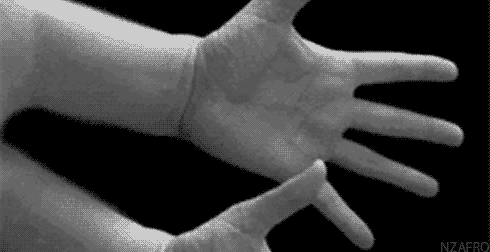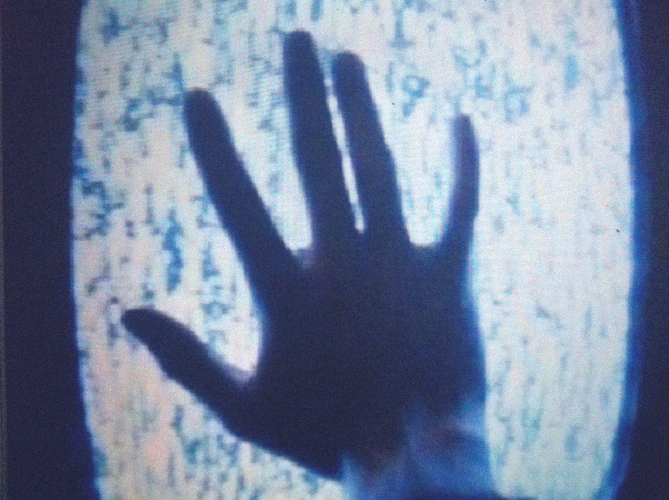Canadian Journal of Film Studies, Fall 1998
This large format, well-illustrated collection of interviews with sixteen non-commercial, independent filmmakers offers a revealing cross section of Canadian experimental/avant-garde/fringe film (the filmmakers themselves are far from unanimous as to what label—if any—belongs on their work). Not only do we learn about the lives, opinion and films of the filmmakers interviewed, but we also enter a collective discourse on what it’s like to work on the fringes of critical recognition, public approval and financial rewards.
As a writer and polemicist as well as a filmmaker, Hoolboom has been part of—indeed, has helped shape—that discourse for many years. Someone should have interviewed him for this volume, but at least his questions and occasional comments convey some of his thoughts on the subject of Canadian fringe film. Hoolboom knows the work of each filmmaker well, which not only indicates respect for their accomplishments, but enables him to use his own analysis and interpretation as a way of prompting filmmakers to discuss their films in greater detail. At other times, he simply says, “Tell me about…” (naming a particular film), and lets the filmmaker take it from there. All the filmmakers talk about when and how they got into filmmaking (nearly all of them studied film, to a greater or lesser degree, in college or university—five went to Sheridan College) and Hoolboom leads them through a discussion of their films in chronological order. Consequently, the interviews yield a great deal of useful information about the films and their makers. The result is both an introduction to, and a source for research on, the filmmakers Hoolboom includes in his book.
While comparable in many ways to Scott MacDonald’s A Critical Cinema: Interviews with Independent Filmmakers (three volumes of which have appeared to date), Hoolboom’s Inside the Pleasure Dome is distinguished by its Canadian content and, consequently, by a sense of film “community” working under common constraints and sharing similar concerns. His book, Hoolboom says in his introduction, “takes aim at a single national expression—Canada’s—and provides a sampling of its artists’ voices.” It must be added, however, that Hoolboom’s “Canada” is Toronto and a few points west. More than half the filmmakers live in Toronto (as does Hoolboom) and he includes no representatives of fringe film from the Maritimes.
Nevertheless, there is considerable variety among the filmmakers interviewed. Their inclusion, Hoolboom insists, does not imply that they are the “greatest or grandest of them all.” They were chosen “according to the criteria of individual interest and aesthetic difference,” and they represent, by Hoolboom’s reckoning, “Canada’s five ‘generations’ of film artists.”.. This mix of older, better-known and younger, less well-known film artists implicitly affirms a continuity and renewal within the perpetually endangered species of Canadian experimental film.
One thread running through the interviews is the notion that experimental film is, indeed, endangered, and that the film medium itself is on the verge of extinction. Snow: “It’s going to die. Part of my life’s work is not only decaying, but soon there won’t be any way to show it.” Torossian: “(Film) seems primitive. It’s so old. I’d like to explore other mediums.” Kerr: “Maybe all this modernist stuff is a cry that film is near the end… Hoolboom: “It’s finished All we can do is talk about what was.” And yet… “On the other hand,” Snow says, “it’s surprising that (experimental film) still exists, that there are young people coming to it. The medium itself still seems inviting and there’s still a lot to be done with it.” Sternberg: “There’s lots of work and what’s good will stay around somehow. And if not, so what?” Brown: “The artist is like a cockroach—we have to be able to eat anything in order to survive. You try to kill us but we keep coming back.” The book’s final words are Cartmell’s: “Certainly I don’t think there’s any reason to be optimistic. But it’s astonishing how things change. A stupid invention in someone’s garage can completely change the way everybody thinks. And there are garages in which the lights are burning all night.”
A related thread is summarized by Snow: “In some ways I can’t understand why experimental film continues to have such a small audience.. I just don’t understand (the) resistance.” Brown observes caustically, “You hardly get any recognition. Avant-garde film is like a pariah, like having leprosy.” More thoughtfully, Kiyooka remarks, “The problem with the reception of marginal art is that the public doesn’t accept it because of where they find it. The context destroys it even before it’s begun.” Issues involving exhibition and reception are staples of the discourse of fringe filmmakers—from “getting screenings” and “the politics of exhibition” (both phrases are Sternberg’s) to self-doubts about one’s own work: “I really liked the films but didn’t expect others would enjoy watching them,” Mead says about the super-8 films he made in film school. When Hoolboom asks Sternberg, “Do we need an audience for this work—do numbers matters? Is there a certain point where public attention wanes so completely that you have to say, okay, let’s pull the plug on this. What if no one comes?” Her reply is, “That’s fine. Then I’ll make it for myself.” Lipskis: “The bottom line for me is to keep making work I think is interesting. I don’t lose sleep over audiences.” Popovich: “Audiences don’t matter… For me the communication isn’t with my audience, it’s with my tools, my medium.” Buitenhuis, on the other hand, says, “I just take my films around…” and not only does she find audiences, but she has discovered that “most insight comes out of discussion rather than in direct response to the work… Response comes when we start talking.”
Buitenhuis’s efforts to “reach other kinds of audiences” and “not preach to the converted” are related to a broader issue addressed, in one way or another, by most of the filmmakers in the book, and it goes to the very heart of what experimental/avant-garde film is, or was, or might be. “Is there an avant-garde today?” Hoolboom asks Brown. “Sure,” he replies, mentioning Hoffman, Sternberg and Chris Gallagher as examples. “Avant-garde means a cutting edge,” Brown continues, “It means taking yourself over the precipice and looking into an abyss and pulling something out of it.” When Hoolboom adds, “Some people would insist that any notion of ‘avant-garde’ includes a political dimension,” Brown fires back, “That’s bullshit. Theory and politics are as fashionable as changing your underwear. The work will last, not the politics… Art is about the politics of seeing and feeling.” Comparable opinions are voiced by Kiyooka: “I don’t make political activist-type films… I think the personal is political,” and Hoffman: “Personal work wasn’t thought of as political back then (the late Seventies) but to my mind it’s the most political.”
For Razutis, “avant-garde” includes “the political, the transformational, the artistic, and those (films) historically linked to other avant-gardes.” Moreover: “I don’t believe it is ‘dead’ or has outlived its usefulness in shaking up the status quo.” Kerr, however, thinks of the avant-garde in historical terms: “(It’s) not something I’m a part of.. When Snow was making Wavelength in New York, that was an avant-garde period. Popovich says much the same thing: “I’m not part of an avant-garde. That was an important term when we were starting out. I don’t see what value it has any more.” Sanguedolce, noting the appropriation of avant-garde techniques in music videos and advertising asks, “Where is the possibility of opposition in all this?” And Cartmell: “There’s an avant-garde that erupts at a certain time, that’s radical and distinct, but eventually it is recuperated and becomes part of a canon and a tradition.” Razutis makes the same point about “underground” film of the Sixties blaming Annette Michelson, P. Adams Sitney and Gene Youngblood for “making schools and movements, which was the beginning of the end: its professionalization, anthologization, academicization. Underground film became art, and that was the demise of the form.”
The creation of “a canon and a tradition,” and the identification of “schools and movements” can be perceived as privileging a-political, formalist work that only a small circle of cognoscenti appreciate. “At what point,” Hoolboom asks Lipskis, “does the practice become elitist and self-serving?” “When the artist becomes arrogant,” Lipskis replies. A somewhat different take on the situation comes from Mangaard, who says that although she doesn’t like to call her work “experimental,” “It gets put into that very male-dominated category.” Calling the experimental film community in Toronto “a boy’s club” and “a closed community,” Mangaard says it is dominated by “attitudes (that) have emerged from the work’s academic base, its masculine history of division.” Hoolboom pushes this argument farther in his interview with Cartmell: “What about the argument that avant-garde film is now, and has traditionally been, a white, male and middle-class preserve. That it’s racist and sexist by exclusion.” And in the bleakest and most condemning characterization of what is, after all, the central subject of his book, Hoolboom asks rhetorically, “Is there any point in making avant-garde films now given its marginality, its inability to see beyond its own formalist history or respond to newer agendas of race, representation and the media? Given the preponderance of white male hegemony, the absence of critical discourse, the lack of exhibition outlets?” It is appropriate that these questions appear in the interview with Cartmell, who has not completed a film in ten years. “I don’t do anything at all,” Cartmell says. “It may be the highest mode of non-compromise. Silence.”
Luckily, neither silence nor abstention from filmmaking has been the collective response of Canadian fringe filmmakers. Nevertheless, it is to Hoolboom’s credit that he poses these difficult questions even if no definitive answers are possible. In effect, he shows the fringe to be contested terrain, not the “closed community” some perceive it to be. Moreover, as Atom Egoyan says in a brief forward to the book, “To treat these films as marginal is to marginalize some integral part of ourselves.” While Hoolboom’s book will not eliminate this marginality, it should at least help to illuminate it.


